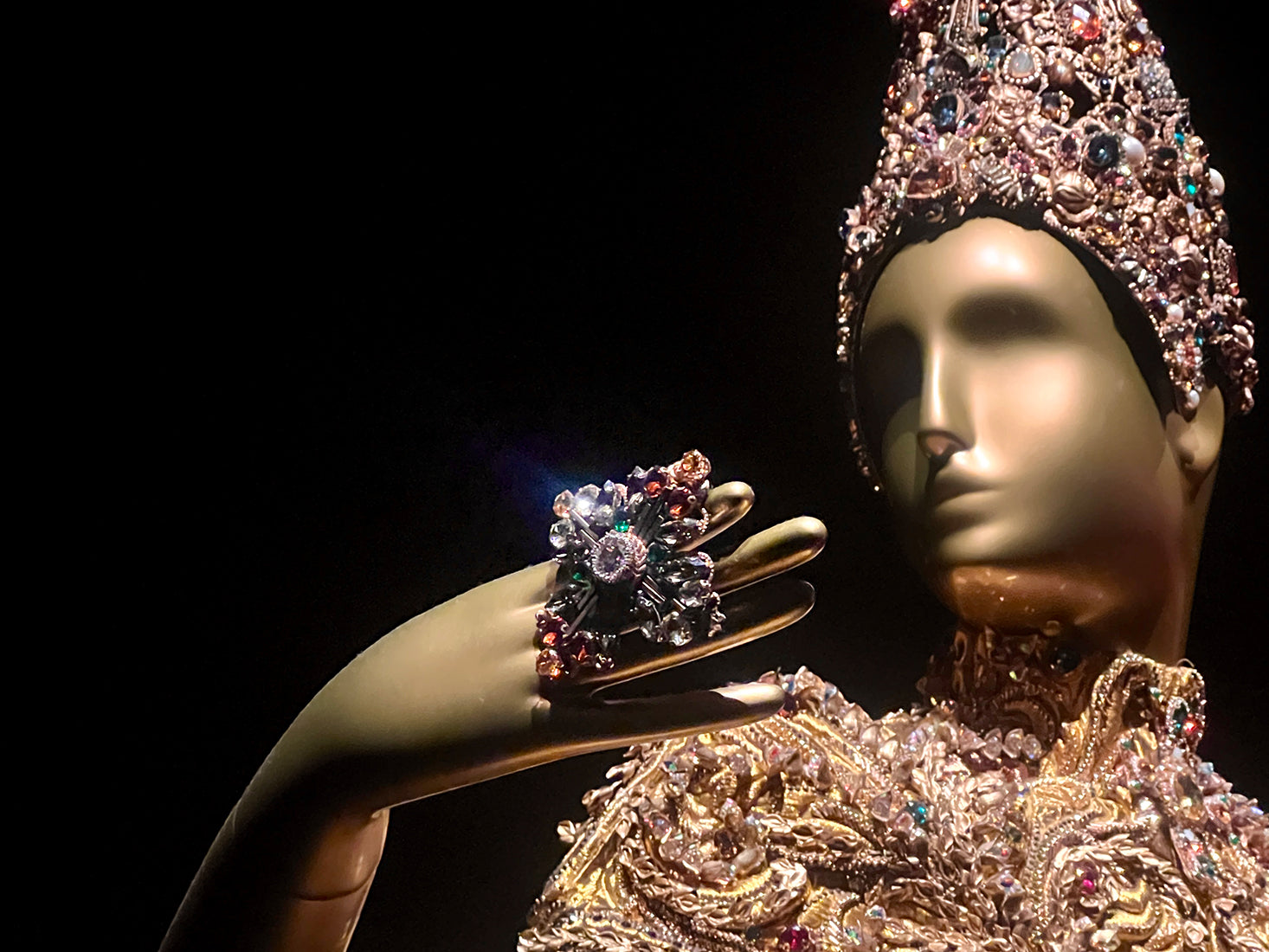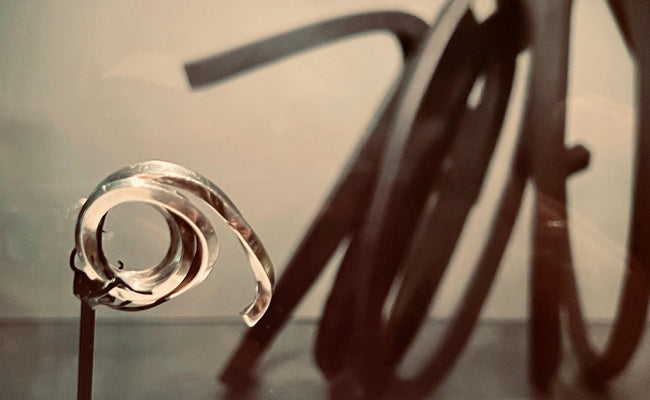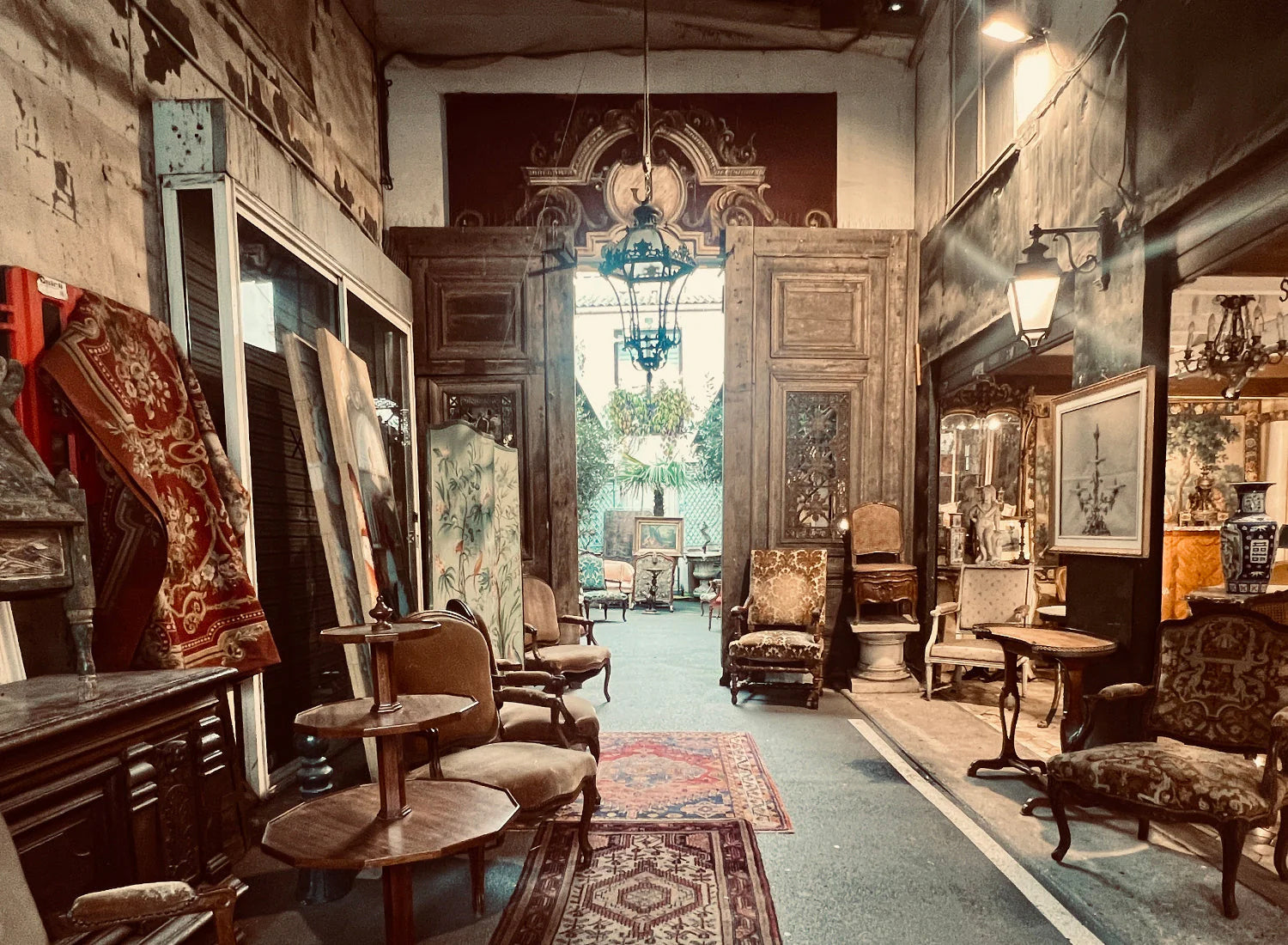
Where Metal Becomes Cloth: Guo Pei’s Golden Thread
I was in Paris not long ago and, like most design-minded people, I had a list. Galleries, ateliers, exhibits… and yes, I wandered over to the much-hyped Dolce & Gabbana retrospective too. But when I saw the line, which was a full-blown circus of stilettos, smartphones, and influencer energy… I quietly stepped away.
That’s how I ended up across the Seine at the Musée du Quai Branly. It's one of those quieter museums that stays open late on Thursdays, and that night, it was almost empty. A few visitors drifted in and out, but for the most part, I had the exhibit to myself. I slipped on the headphones they handed me at the entrance and stepped into a hushed, gold-threaded world. It was a different kind of “quiet luxury.” Not the kind whispered through beige cashmere and minimalism, but one that dazzles. Every piece radiated opulence. Maximalist, theatrical, unapologetically ornate. The room might have been quiet, but visually, the effect was anything but. The exhibition celebrated global fashion, but Guo Pei’s work stood apart. Her pieces felt monumental, both visually and structurally.



GILDED THREAD BEFORE AND AFTER. THE TRANSFORMATION FROM RAW MATERIAL TO GARMENT IS WHERE THE MAGIC LIVES. PHOTOS: ©ALLOYALIST
Who is Guo Pei?
If you don’t know her work, Guo Pei is a Chinese designer best known (at least in the Western world) for the golden cape Rihanna wore to the Met Gala a few years back. You know, the one that took up half the red carpet... But beyond that moment, her work is all about meticulous handcraft and historical references turned on their head. Pei is sometimes called China’s first couturier, but her work speaks to many cultures and eras all at once. She draws from Qing dynasty robes, European court dress, ecclesiastical embroidery, temple art, Gothic architecture and more... yet her clothes never feel like replicas. She’s not recreating; she’s translating.
TOP: 18TH CENTURY JAPANESE CEREMONIAL UCHIKAKE MADE OF EMBROIDERED SILK AND GOLD. BELOW: GUO PEI'S INTERPRETATION FOR HER AW2016 COLLECTION, "ENCOUNTER". YOU CAN SEE THE INSPIRATION IN THE FLARED SLEEVES, LAYERING, LAVISH EMBROIDERY, AND GOLD THREADS THROUGHOUT. PHOTOS: ©ALLOYALIST
Pei’s use of gold thread is a perfect example. Historically, gold embroidery was a sign of power, often reserved for royalty or religious elites. In China, emperors wore dragon robes embroidered in gold to signify cosmic authority. In Europe, vestments and altar cloths shimmered with metallic threads that were more metal than thread—thin wires of gold or silver wrapped around silk.
Guo Pei takes that tradition and pushes it forward. Her gold thread doesn’t just sit on the surface. It builds the garment. Many pieces featured architectural scrollwork in metallic thread, almost like walking inside an engraving. The embroidery had weight. It sculpted the silhouette as much as any corset or crinoline could.
The Details that Stopped Me
Some favorites of the exhibit include phoenixes unfurling across the back of a cape, their feathers abstracted into flame-like plumes. A high-necked gown that featured swirling botanical motifs done entirely in metallic thread, like a baroque engraving brought to life. The embroidery overall isn’t ornamental. It’s architectural, shaping the silhouette, creating movement, weight, and volume.
One headpiece in particular stood out. It was a kind of filigree lattice, somewhere between a reliquary crown and a Dali sculpture. It played with Catholic iconography and ancient Chinese hair ornaments, but with a geometric twist that felt almost sci-fi. Another look paired a stiff, golden robe with platform shoes that could have stepped out of a Ming dynasty opera, but reimagined for a modern, surrealist runway.


There’s also a sense of reuse, not in the literal “sustainable fashion” way, but in how Pei revisits ideas. A certain sleeve shape might recall a 17th-century robe; a motif might feel lifted from a temple carving. But then she throws in a modern silhouette or an unexpected texture, and it becomes something else entirely.


It reminded me why I’m drawn to older things in the first place... not because they’re old, but because they have layers. And Guo Pei knows how to build layers into her work: metaphorically, historically, and physically. I can’t imagine my time in Paris without seeing these sculptural garments up close. A few times I even set off the alarm by leaning in too much, completely absorbed. I didn’t notice until the guards gently reminded me I needed to step farther away.
Serendipity in the City of Light
Later that night, I left the museum and found myself directly beneath the Eiffel Tower, not from the usual plaza, but tucked down a quiet side street. Just as I looked up, the lights began to sparkle. No crowds, no fanfare, just me, standing under iron and light, by complete accident.
As I walked back toward where I was staying, the line at Dolce was still going strong ! It was still wrapped around the block, just as I’d happily left it. I was so happy to discover that Guo Pei’s gowns may be anything but subtle, but the experience of seeing them nearly alone, with time to take in every thread and reference, felt like its own kind of quiet luxury. For a goldsmith with a love of history, it was exactly the kind of brilliance I came to Paris hoping to find.
When to go and How to Get There
The exhibition Au fil de l’or (Golden Thread) at the Musée du Quai Branly – Jacques Chirac in Paris is scheduled to run until July 6, 2025.
Address: 37 Quai Branly, 75007 Paris, France
Nearest Metro: Alma-Marceau (Line 9) or Bir-Hakeim (Line 6)
Hours: Open Tuesday–Sunday, 10:30 AM to 7:00 PM
Evening Hours: Thursdays until 10:00 PM — perfect for post-dinner wanderings
Closed Mondays
Admission: €12 standard, free for EU residents under 26
Tip: Book tickets online to skip the ticket line and head straight in
Best Times to Visit:
- Thursday evenings for a calm, contemplative experience (you might even have the gallery to yourself)
- Weekday mornings if you’re an early riser
- Avoid weekends if you’re seeking solitude
Pro tip: Leave a few minutes before the hour to catch the Eiffel Tower shimmer in Paris’s own gilded finale. Not a bad way to end an evening.





Leave a comment
This site is protected by hCaptcha and the hCaptcha Privacy Policy and Terms of Service apply.